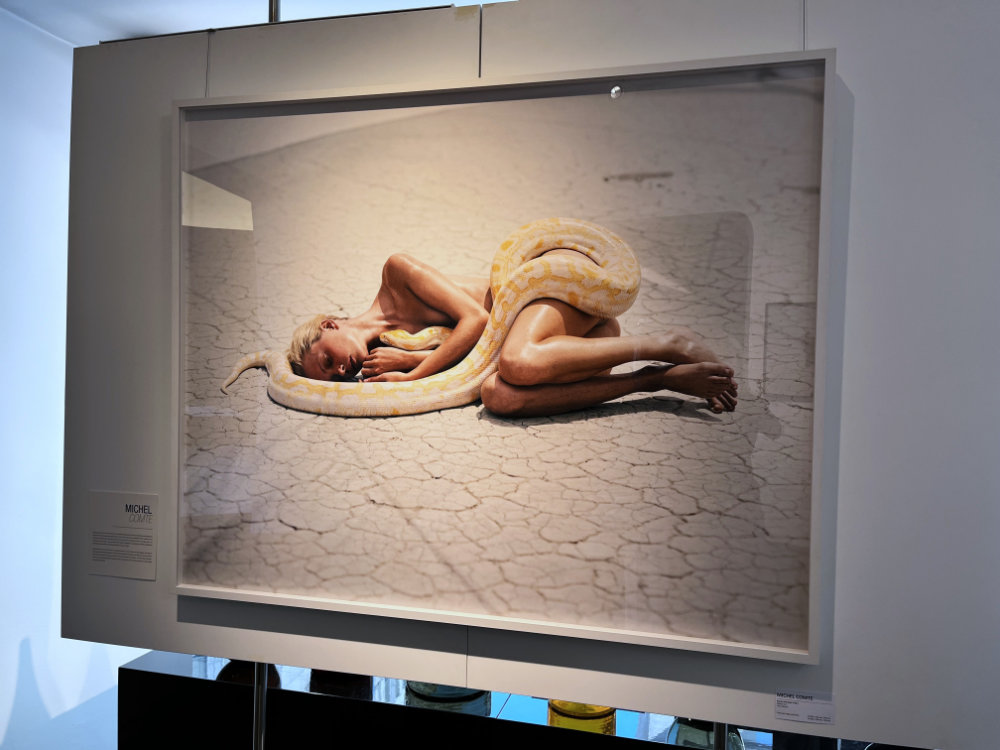Andreas H. Bitesnich, Yvonne & Tom #66
Between Glass and Grain: Enhancing Photography with the Perfect Frame
Framing fine art photography is more than just a method for displaying artwork; it’s an essential part of presenting a photograph in a way that complements and enhances its visual appeal. The right frame can transform the look and feel of an image, bringing out subtle tones and adding depth, while a poorly chosen frame might distract from the photograph’s essence. This blog post explores the nuances of framing fine art photography, including the impact of a passepartout, the materials and styles of frames, the choice of glass, and how to find the perfect frame for your art.
Massimo Listri, Biblioteca Apostolica, 2015
The Role of a Passepartout in Framing
A passepartout, also known as a mat, is a border made of thick paper or card that sits between the frame and the artwork. Its role goes beyond mere decoration—it acts as a breathing space between the image and the frame, allowing the viewer’s eye to focus more on the artwork itself. By providing a neutral border, a passepartout can add depth to the photograph, making it appear more isolated and centered.
The color of the passepartout can dramatically change the mood of a framed photograph. White or light-colored mats often create a clean, airy feel, emphasizing brighter tones in the image. Conversely, darker mats can add a sense of drama, drawing attention to shadows and richer hues. Passepartouts are especially effective for smaller photographs, as they can make the artwork appear larger and more substantial on the wall. The right choice of passepartout color and size can elevate the photograph, giving it a sense of gallery-like presentation.

Lorieux, Dior: Royal Palm
Exploring Frame Materials: Wood, Metal, and Everything in Between
The choice of frame material is another crucial aspect of framing fine art photography. Generally, sleek, simple frames—often black, white, or natural wood—are preferred for photography. This minimalism ensures that the focus remains on the artwork without the frame competing for attention. Here’s a breakdown of common frame materials:
- Wood Frames: Natural wood frames bring a touch of warmth and texture, offering a more organic feel that can complement black-and-white as well as color photography. Woods like maple or oak can be stained or left natural, creating different vibes that range from rustic to modern.
- Metal Frames: Aluminum or steel frames are popular for a contemporary, clean look. They’re often available in black, silver, or white finishes, which pair well with the sleek presentation of fine art photography. Metal frames are durable and tend to have a thinner profile, which can give a subtle modern edge.
- Acrylic Frames: For a modern and minimalist style, acrylic or plexiglass frames are an option. These provide a transparent look that can make the image appear as if it’s floating on the wall. Acrylic frames are lightweight and add a sense of depth without adding bulk.

The Power of Simplicity
Photography is often framed in simple, understated frames for a reason—this style does not distract from the photograph itself. A clean black or white frame creates a timeless look that allows the image to shine. Black frames are particularly effective at framing black-and-white images, complementing the deep contrast and creating a cohesive visual experience. White frames, on the other hand, can enhance lighter photographs, giving them a bright, fresh presentation. The simplicity of these frames keeps the focus on the content of the image, respecting the artist’s vision and the viewer’s experience.
Liu Bolin, Hiding III
The Choice of Glass: Clarity and Protection
Fine art photographs can be vulnerable to fading if exposed to direct sunlight over time. UV-resistant glass helps protect against the harmful effects of UV rays, preserving the colors and integrity of the image. This is especially important for photographs with vibrant colors that you wish to maintain over the years. The type of glass used in framing can also significantly impact how a photograph is viewed and preserved. Different types of glass offer varying levels of protection and visibility. In collaboration with our trusted framing partners in Vienna, Preiss Fine Arts offers the following UV-Resistant Options:
- Acrylic Glass: This is the most common type of glass used in framing and is usually cost-effective. However, it can create reflections, which might detract from the viewing experience, especially in rooms with lots of light sources.
- Non-Reflective Glass: Also known as anti-glare or museum glass, this type reduces reflections, making it easier to view the photograph from different angles. It’s ideal for spaces with a lot of natural light but can be slightly more expensive and makes bigger frames significantly more heavy.
- Museum Plexiglass: This lightweight alternative to Museum Glass is less prone to shattering, making them suitable for larger frames or areas where safety is a concern. However, they can scratch more easily, so care should be taken when handling and cleaning them.
Michel Comte, Tatjana with Snake, Beauty & Beast
Finding the Perfect Frame: What to Consider
Selecting the ideal frame for your fine art photograph can feel like a balancing act between enhancing the image and complementing its intended atmosphere. Here are some key factors to help guide your choice:
- Reflect the Tone of the Artwork: The frame should echo the feeling of the photograph. For example, a bright, colorful image might pair well with a white or natural wood frame, while a moody, black-and-white photograph may be enhanced by a sleek black frame.
- Consider the Environment: Think about where the framed piece will hang. A frame that fits well with the surrounding decor can create a more cohesive look. Additionally, considering the lighting conditions in the space can help determine the best type of glass to use.
- Stay True to Your Style: While it’s important to respect the aesthetic qualities of the photograph, don’t be afraid to bring your personal style into the framing decision. Custom framing allows for creativity, making it possible to choose unique materials and colors that resonate with you.
Julia Sent, Dry Fish and Garlic Lorieux, Dior: Royal Palm Joachim Schmeisser, Bull with one Bird
The Art of Presentation
Framing is a crucial element in presenting fine art photography, transforming an image from a simple print into a piece of art that commands attention. By carefully considering the passepartout, frame materials, and glass, you can create a display that enhances the photograph’s aesthetic and protects its integrity over time. Whether you opt for a classic black frame or explore a custom design, the right framing choice can elevate your fine art photography, turning it into a lasting visual experience.
Of course our Team at Preiss Fine Arts is happy to support you throughout the whole art acquisition journey and with 15 Years of experience, we are also happy to advise you on the decision for the perfect frame.
Kristian Schuller, Tush 2022






